
Maximilian Johannes Maria Hubert Reichsgraf von Spee was a naval officer of the German Kaiserliche Marine, who commanded the East Asia Squadron during World War I. Spee entered the navy in 1878 and served in a variety of roles and locations, including on a colonial gunboat in German West Africa in the 1880s, the East Africa Squadron in the late 1890s, and as commander of several warships in the main German fleet in the early 1900s. During his time in Germany in the late 1880s and early 1890s, he married his wife, Margareta, and had three children, his sons Heinrich and Otto and his daughter Huberta. By 1912, he had returned to the East Asia Squadron as its commander, and was promoted to the rank of Vizeadmiral the following year.

SMS Pommern was one of five Deutschland-class pre-dreadnought battleships built for the Kaiserliche Marine between 1904 and 1906. Named after the Prussian province of Pomerania, she was built at the AG Vulcan yard at Stettin, Germany, where she was laid down on 22 March 1904 and launched on 2 December 1905. She was commissioned into the navy on 6 August 1907. The ship was armed with a battery of four 28 cm (11 in) guns and had a top speed of 18 knots. The ships of her class were already outdated by the time they entered the service, being inferior in size, armor, firepower, and speed to the revolutionary new battleship HMS Dreadnought.
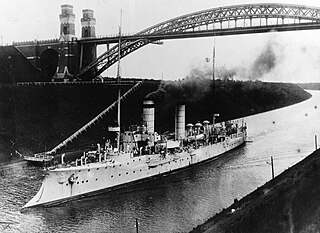
SMS Arcona was the ninth member of the ten-ship Gazelle class of light cruisers that were built for the German Kaiserliche Marine in the late 1890s and early 1900s. The Gazelle class was the culmination of earlier unprotected cruiser and aviso designs, combining the best aspects of both types in what became the progenitor of all future light cruisers of the Imperial fleet. Built to be able to serve with the main German fleet and as a colonial cruiser, she was armed with a battery of ten 10.5 cm (4.1 in) guns and a top speed of 21.5 knots. Arcona was a modified version of the basic Gazelle design, with improved armor and additional coal storage for a longer cruising range.
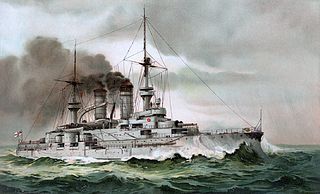
The Wittelsbach-class battleships were a group of five pre-dreadnought battleships built for the German Kaiserliche Marine in the early 1900s. They were the first battleships ordered under the Second Navy Law of 1898, part of Admiral Alfred von Tirpitz's fleet expansion program. The class comprised the lead ship, Wittelsbach, and Wettin, Zähringen, Schwaben, and Mecklenburg. All five ships were laid down between 1899 and 1900 and were finished by 1904. The ships of the Wittelsbach class were similar in appearance to their predecessors in the Kaiser Friedrich III class, but had a more extensive armor belt and a flush main deck, as opposed to the lower quarterdeck of the previous class. Both classes carried a battery of four 24 cm (9.4 in) guns in two twin-gun turrets.

The Braunschweig-class battleships were a group of five pre-dreadnought battleships of the German Kaiserliche Marine built in the early 1900s. They were the first class of battleships authorized under the Second Naval Law, a major naval expansion program. The class comprised five ships—Braunschweig, Elsass, Hessen, Preussen, and Lothringen—and they were an improvement over the preceding Wittelsbach class. The Braunschweigs mounted a more powerful armament of 28 cm (11 in) and 17 cm (6.7 in) guns. Less than two years after the first members of the class entered service, the ships were rendered obsolescent by the British all-big-gun battleship Dreadnought, which curtailed their careers.
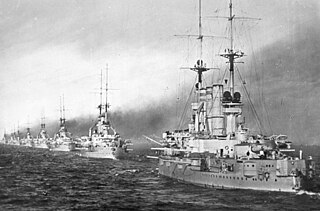
The Deutschland class was a group of five pre-dreadnought battleships built for the German Kaiserliche Marine, the last vessels of that type to be built in Germany. The class comprised Deutschland, the lead ship, Hannover, Pommern, Schlesien, and Schleswig-Holstein. The ships closely resembled those of the preceding Braunschweig class, but with stronger armor and a rearranged secondary battery. Built between 1903 and 1908, they were completed after the launch of the revolutionary British all-big-gun battleship HMS Dreadnought in 1906. As a result, they were obsolescent before entering service. The ships nevertheless saw extensive service in the High Seas Fleet, Germany's primary naval formation, through the late 1900s and early 1910s, when they were used for training, which included overseas cruises.
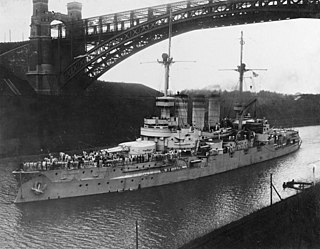
SMS Lothringen was the last of five pre-dreadnought battleships of the Braunschweig class, built for the German Kaiserliche Marine. She was laid down in December 1902, was launched in May 1904, and was commissioned in May 1906. She was named for Lothringen, a province of the German Empire from 1871 to 1918. The ship was armed with a battery of four 28 cm (11 in) guns and had a top speed of 18 knots. Like all other pre-dreadnoughts built around the turn of the century, Lothringen was quickly made obsolete by the launching of the revolutionary HMS Dreadnought in December 1906; as a result, her career as a front-line battleship was cut short.

SMS Eber was a steam gunboat built for the German Kaiserliche Marine in the 1880s, the only ship of her class. Intended to serve abroad, the ship was ordered as part of a construction program intended to modernize Germany's fleet of cruising vessels in the early-1880s. She was armed with a main battery of three 10.5 cm (4.1 in) guns and had a top speed of 11 knots.

SMS Adler was the third and final gunboat of the Habicht class built for the German Kaiserliche Marine in the early 1880s. Intended to serve abroad, the ship was ordered as part of a construction program intended to modernize Germany's fleet of cruising vessels in the mid-1870s. The Habicht class was armed with a battery of five guns, and was the first class of German gunboat to use compound steam engines. The ship had a top speed of 11 knots.

SMS Danzig was a light cruiser of the Imperial German Navy. Named for the city of Danzig, she was the seventh and last ship of the Bremen class. She was begun by the Imperial Dockyard in her namesake city in 1904, launched on 23 September 1905 and commissioned on 1 December 1907. Armed with a main battery of ten 10.5 cm (4.1 in) guns and two 45 cm (18 in) torpedo tubes, Danzig was capable of a top speed of 22 knots.
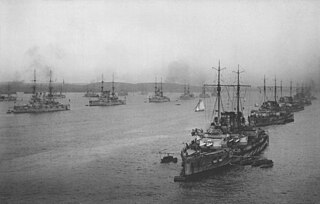
The II Battle Squadron was a unit of the German High Seas Fleet before and during World War I. The squadron saw action throughout the war, including the Battle of Jutland on 31 May – 1 June 1916, where it formed the rear of the German line.

The Bismarck-class corvettes were a class of six corvettes built for the German Kaiserliche Marine in the 1870s. The six ships were Bismarck, Blücher, Stosch, Moltke, Gneisenau, and Stein. The Bismarck-class corvettes were ordered as part of a major naval construction program in the early 1870s, and they were designed to serve as fleet scouts and on extended tours in Germany's colonial empire. The ships were armed with a battery of between ten and sixteen 15 cm (5.9 in) guns and they had a full ship rig to supplement their steam engine on long cruises abroad. One ship, Blücher, was converted into a torpedo testing and training ship shortly after she was completed, having her guns replaced with a variety of torpedo launchers.
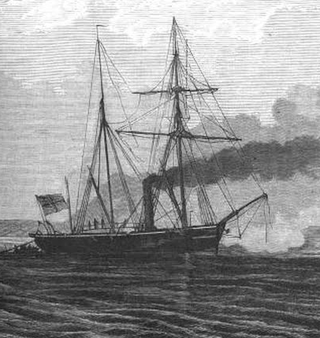
The Camäleon class was a group of gunboats built for the Prussian Navy. Eight ships comprised the class: Camäleon, Comet, Cyclop, Delphin, Blitz, Basilisk, Meteor, and Drache. The vessels were armed with a battery of one 15 cm (5.9 in) gun and two 12 cm (4.7 in) guns. In 1865, the ships then in service had their 15 cm gun replaced with a 21 cm (8.3 in) gun; Meteor and Drache, not yet completed, entered service with that gun. The vessels saw action during the wars of German unification, with Comet taking part in the Battle of Jasmund and Blitz and Basilisk present during the Battle of Heligoland, both during the Second Schleswig War in 1864. Several of the ships served in the North Sea during the Austro-Prussian War, where some of them supported operations against the Kingdom of Hanover. During the Franco-Prussian War, Meteor battled the French aviso Bouvet in the Battle of Havana in 1870; the other members of the class were deployed on coastal defense assignments.

The Carola class was a group of six screw corvettes built by the German Kaiserliche Marine in the late 1870s and 1880s. The class comprised Carola, the lead ship, Olga, Marie, Sophie, Alexandrine, and Arcona. They were ordered to replace older sailing vessels that were no longer sufficient to protect German interests around the world. Intended for service in the German colonial empire, the ships were designed with a combination of steam and sail power for extended cruising range, and they were equipped with a battery of ten 15-centimeter (5.9 in) guns. Relying primarily on sail power for their long-range deployments, the ships were obsolescent before construction began.
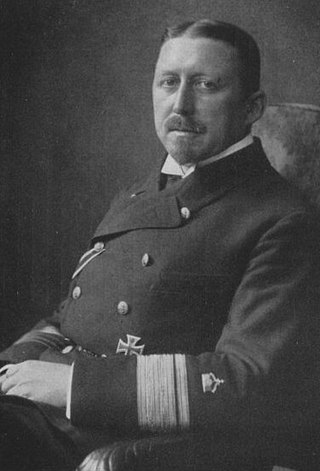
Andreas Heinrich Michelsen was a German Vizeadmiral and military commander. During World War I, he commanded several torpedo boats and the submarine fleet, participated in the Battle of Jutland, as well as being the leading German commander during the Battle of Dover Strait.

The Jäger class of steam gunboats was a class of fifteen ships that were built for the Prussian Navy in the late 1850s and early 1860s. The class, which were the first steam gunboats built for the Prussian fleet, comprised the following vessels: Jäger, Crocodill, Fuchs, Hay, Scorpion, Sperber, Hyäne, Habicht, Pfeil, Natter, Schwalbe, Salamander, Wespe, Tiger, and Wolf. They were armed with three guns and were intended to guard the Prussian coast in the shallow waters of the Baltic Sea. They proved to handle poorly in service, and as a result, spent much of their existences laid up ashore. Several of the boats were activated during the Second Schleswig War in 1864, and some took part in a minor battle against Danish warships. Crocodill was scrapped in 1867 due to her poor condition, but the rest of the class remained in the fleet's inventory into the 1870s, when they began to be discarded. Most of the ships served on as storage barges, usually for naval mines, though Jäger and Wolf were both sunk as target ships.

The Habicht class of screw gunboats was a class of three vessels built for the German Kaiserliche Marine in the late 1870s and early 1880s. The class comprised Habicht, the lead ship, along with Möwe and Adler. Intended to serve abroad, the ships were ordered as part of a construction program intended to modernize Germany's fleet of cruising vessels in the mid-1870s. The Habicht class was armed with a battery of five guns, and was the first class of German gunboat to use compound steam engines. The ships had a top speed of 11 knots.
















